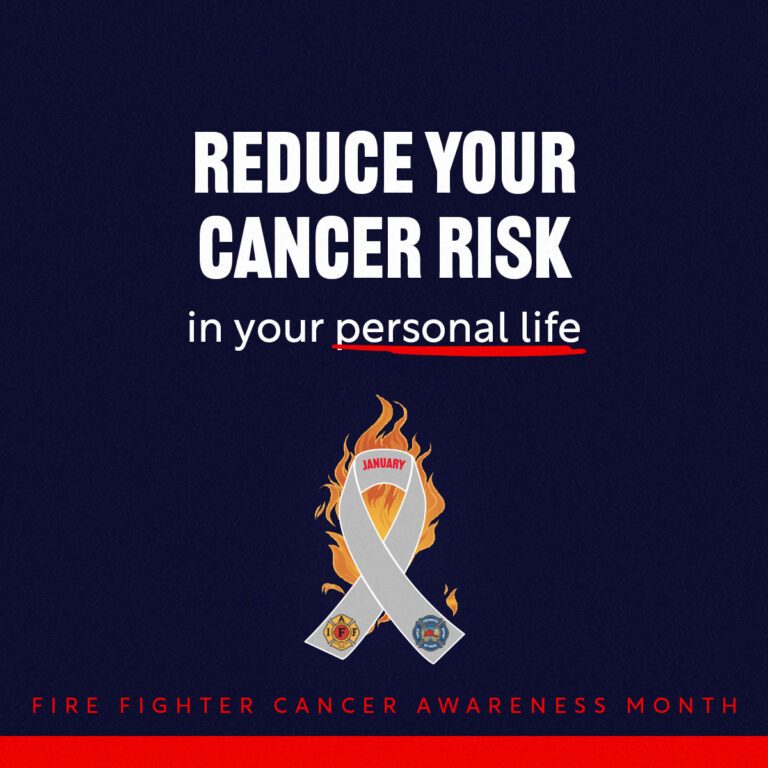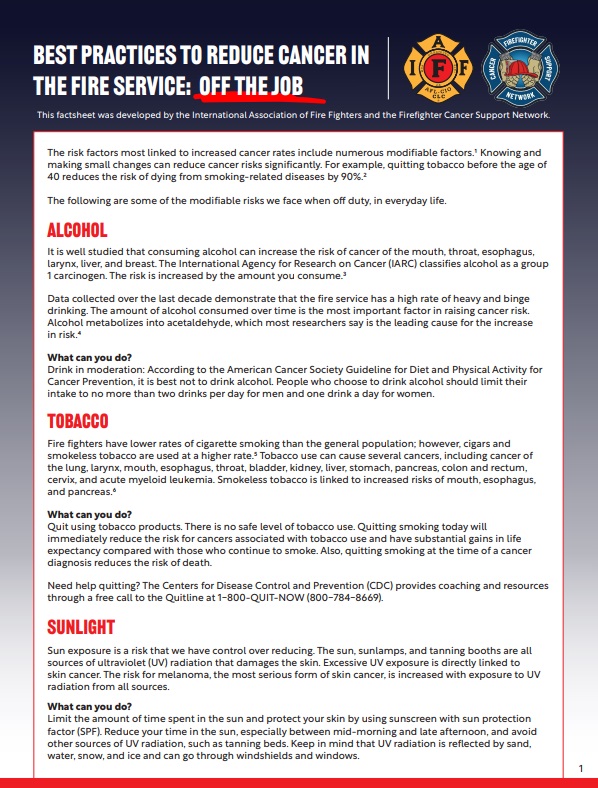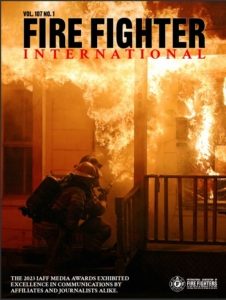
The risk factors most linked to increased cancer rates include numerous modifiable factors. Knowing and making small changes can reduce cancer risks significantly. For example, quitting tobacco before the age of 40 reduces the risk of dying from smoking-related diseases by 90%. Alcohol and tobacco consumption, obesity/diet, and sunlight exposure can all help mitigate (or worsen) a Member’s risk factors both on and off the job. Stress and sleep (or lack thereof) also play a factor.
Your occupational exposures cannot change, but you can adopt safer policies and habits to reduce your exposure to toxic chemicals. Off duty there are additional factors that can increase your risk of developing cancer. While some risk factors cannot be avoided, others can be modified to promote health. Knowing the risk and modifying lifestyles can in many ways provide a buffer to the occupational exposure fire fighters in various situations cannot be avoided.
The below thumbnail links to a PDF file of easy-to-implement things to help you stay healthy off the job (and thereby, too, on the job).

Smoke Detector Program
miscPlease note: this program is limited to battery powered alarms. We are not able to work on detectors that are wired into your home’s electrical system.
CLICK THE GRAPHIC AT LEFT FOR A FULL SIZED JPG VERSION OF THE FLYER.
Supporting Our Community Every Day
misc, NewsYour Mifflin Township Professional Firefighters are more than just responders; we’re your trusted experts in public safety. Every day, rain or shine, we strive to ensure that each citizen feels secure and protected. From fire emergencies to medical crises, we’re committed to delivering top-notch fire/rescue and EMS responses with the resources we have.
Our dedication goes beyond the call of duty. We’re here to serve, to protect, and to make a difference in the lives of our neighbors. Thank you for trusting us with your safety. Together, we’ll continue to uphold our mission to be the guardians our community deserves. Stay safe, Mifflin Township and Gahanna!
GAHANNA GIFT SHOP
miscLocal 2818 and Mifflin Fire are proud to partner with our friends and colleagues at Gahanna Police to participate in the 8th Annual Gahanna Gift Shop. This program will help to get Christmas presents to those in our community who might be in need of assistance. Donating is easy! Visit gahannagiftshop.com or use the QR code to go to the shopping list. There are items there that fit most price points.
Thank you for participating and helping our fellow community members this Holiday Season! A PDF version of this flyer can be downloaded by clicking on this link .
CLICK THE FLYER TO ENLARGE
New FFI Available
NewsThe newest edition of IAFF’s FFI is available from the Members Area of this website. Login required.
Survivor Story: Mary Blaul, Orange County CA, Local 3631
NewsSurvivor Story: Larry Zuber: Evansville, IN Local 357
NewsSurvivor Story: Ian Da Costa: Laguna Beach CA L3684
NewsCALL TO ACTION: OFF DUTY
NewsSo, taking care of yourself off duty is just as important as in the station or on a call. Go easy with the alcohol. SMOKING IS BAD FOR YOU (unless it’s at the barbecue). Get your screenings done. Stay active. Try to keep a standard sleeping schedule. And, yes, naps are okay. And, your brain is a muscle, too. Take care of it; you only get one. Clicking on the thumbnail below opens a PDF with easy to implement
nap schedulesthings to keep yourself in good shape for the job, for your crew, for your family, FOR YOU.Best Practices Off the Job
NewsThe risk factors most linked to increased cancer rates include numerous modifiable factors. Knowing and making small changes can reduce cancer risks significantly. For example, quitting tobacco before the age of 40 reduces the risk of dying from smoking-related diseases by 90%. Alcohol and tobacco consumption, obesity/diet, and sunlight exposure can all help mitigate (or worsen) a Member’s risk factors both on and off the job. Stress and sleep (or lack thereof) also play a factor.
Your occupational exposures cannot change, but you can adopt safer policies and habits to reduce your exposure to toxic chemicals. Off duty there are additional factors that can increase your risk of developing cancer. While some risk factors cannot be avoided, others can be modified to promote health. Knowing the risk and modifying lifestyles can in many ways provide a buffer to the occupational exposure fire fighters in various situations cannot be avoided.
The below thumbnail links to a PDF file of easy-to-implement things to help you stay healthy off the job (and thereby, too, on the job).
CALL TO ACTION: Awareness on the Fireground
NewsEasy to implement instructions on how to reduce your cancer risk before the fire, on the fireground, and after the fire. The image above links to a downloadable pdf.